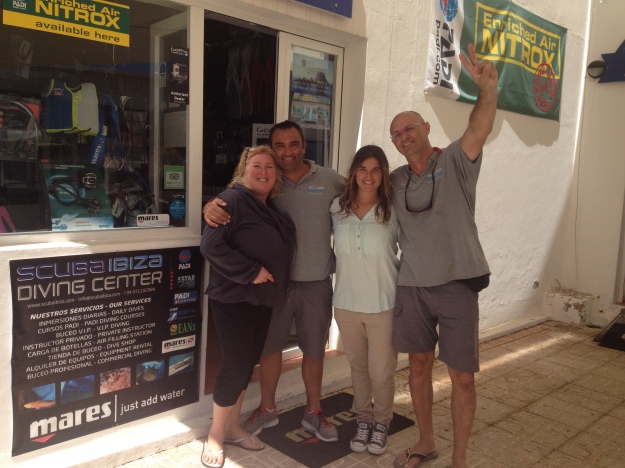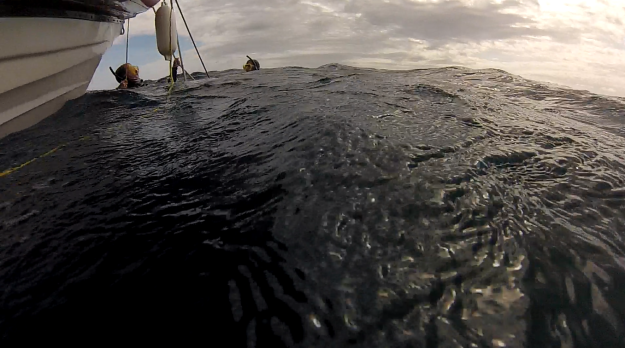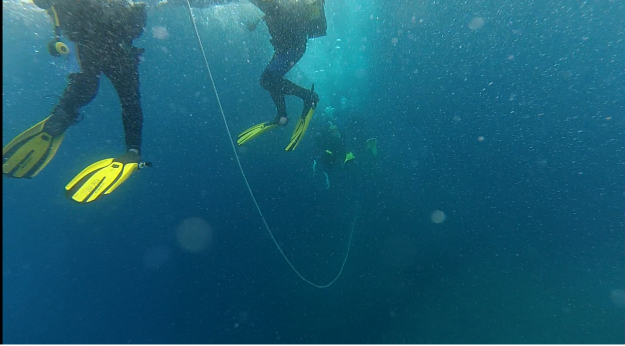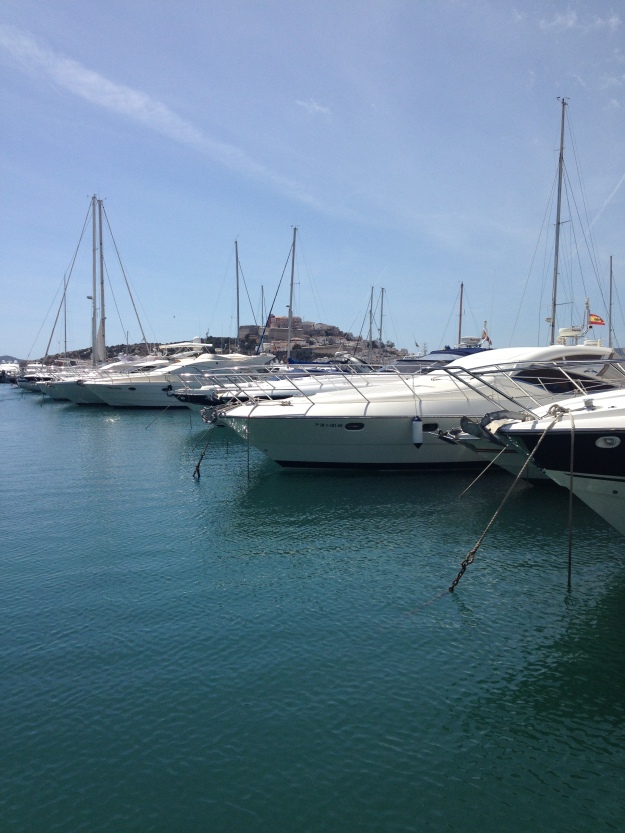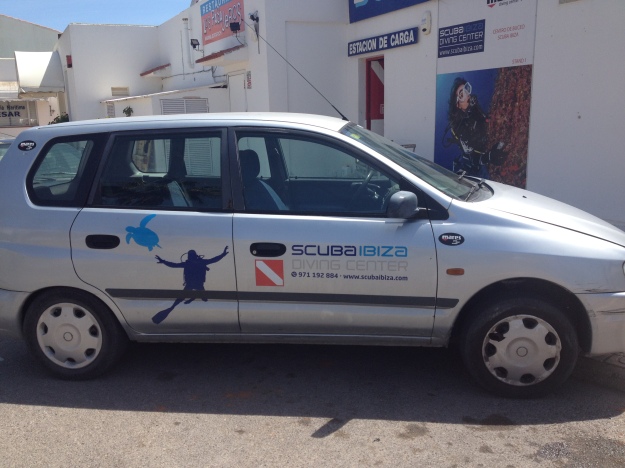Travel Blogs
There is Something Sensual About Saying the Words “I am going to Scuba Dive in Ibiza”
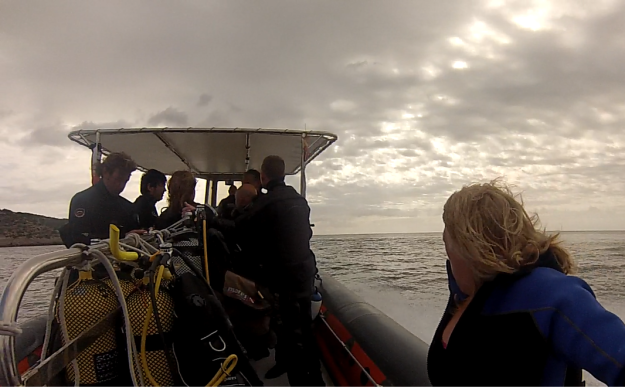
There is something sensual about saying the words “I am Scuba Diving in Ibiza,” so I was hoping the reality was going to match up!
Arriving off our Norwegian Airlines flight on the white isle late in the evening meant an early morning rising in order to arrive at Scuba Ibiza’s dive shop by 9.30 am. I stood bleary eyed on my hotel balcony listening to the relaxing bird song which was emanating from the surrounding pine forest.
The drive from our hotel to Marina Botafoch (where the dive school is situated) took approximately 35 minutes. The roads were signposted clearly and the dive school at the marina was pretty easy to find without being given directions.
I had been in contact in the weeks leading up to the trip via email with Yaqui, the co-owner of Scuba Ibiza, and he had informed me that the boat left the harbour around 9.30 am and arrived back to shore about 13.30. As he asked me “not to be one of these people who do not turn up.” I wondered if this happened a lot in Ibiza.
The whitewashed building looked full of hustle as I peeked my head into the changing room and was directed to the shop entrance by the other co-owner Paulo.
Yaqui greeted us with a smile, handing us a form to fill in for the company Padi records. I paid 6 euros for dive insurance – which is a necessity whenever you scuba dive in Spain. Usually I sort dive insurance out in the UK, but this time, I thought I would try out how it all worked in Spain. It couldn’t have been easier. Arranged in just a click of a button. Within a moment, my dive insurance for the day had been sorted out.
Yaqui then took me out the back to size me up for wetsuit and fins. I noticed all were in excellent condition. I was to wear a 5 mm wetsuit with a shorty on top. Scuba Diving Ibiza had advised completing a drysuit course, as wearing a drysuit was the best option for scuba diving in Mediterranean waters at this time of year (15° is the average water temperature in the month of April, rising to a balmy 30° in the summer months), but alas I didn’t have the time, so settled for the next best thing.
Up one side of the wall, plastic boxes were laid out in rows and numbered – the shop being a safe place to leave our clothes and valuables whilst out on the dive. Scuba Diving Ibiza were making things easy.
At each step Yaqui explained what would be happening. After sorting out the correct gear, our next step was to head to the boat and connect our tank to our regulators. I always find I’m a bit rusty with this step, no matter how many times a year I dive. Yaqui advised spending a week with a dive school, so the first day nerves and jitters could be got over and out of the way, leaving the rest of the week to enjoy the diving. His advice made sense and I definitely would like to find somewhere where I can make the most of good weather, warm relaxing calm conditions (small group numbers) and great customer service to really get the best out scuba diving without feeling continuously challenged. I’d like to relax into it…
Yaqui supervised my connecting of my regulator to my tank, sharing with me the way in which Scuba Ibiza checked out the gear, leaving the tank turned off for our return back to the shop to kit up.
Once we were all ready we made our way back to the rib, where we effortlessly glided out of the harbour to our first dive site. On the way Yacqui explained the kind of dive we would be experiencing at Llado Sur just 4km from Ibiza harbour.
“Currents are normally found here, around four times a year,” was the last thing I can remember him telling me before finally kitting up, feeling claustrophobic and back rolling into the sea. This dive was one of those four times.
Paulo had thrown out a buoy line to assist with the drag of the current and to pull us to the anchor line, if needed. I needed it.
I realised one of the differences between scuba diving in Europe, as opposed to diving in countries such as Asia, Australia and New Zealand. When descending the group has gone down together. In the places I have dived in Europe, each diver descends individually. I found this more unnerving initially – especially knowing that I have trouble with my descent because of nerves, but here I just kept hold of the anchor line and crossed my legs behind me to stop their unconscious kicking. Then calming my breathing to a slow and steady rate, I made my way down to the others at 16mtrs – eventually hovering above a green meadow of sea grass.
The cold hit me as soon as I entered the water – an immediate headache (brain freeze) pounded me in the cold. I had chosen not to wear my hood, as I don’t like feeling enclosed, which I instantly regretted. I concentrated on my buoyancy as we began to make our way round the craggy shelf observing a small school of barracuda. I thought I would be more nervous as this was the first time I had dived without Vinnie for a long time, but dealing with the current as Yaqui assisted the other divers, acknowledging the brain freeze as it continued and enjoying the brown octopus as it suckered itself to Yaqui’s gloved hand – held me mesmerised for the 40 minute dive. One of the things I managed to sort out during this dive was how I let the air out of my BCD – Yacqui corrected my technique. He recognised that I wasn’t upright each time I attempted to do so, and showed me what to do with hand signals. I finally managed to get it right and it made things so much easier. One more thing I learned. Our ascent had us committing to the 5 metres, 3 minute safety stop, and as soon as my cold head broke the surface tension, Paulo was directing me to the back of the boat. He then helped me up, removed my BCD, tank and fins and I was able to flop down exhausted.
I was immediately hit by seasickness.
Vince had already been throwing up, after a failed attempt to snorkel in the strong current, and our pale faces were a reflection of how the other was feeling. The point on my body between my wrists and elbow seemed to be the coldest and my mind felt a tad overwhelmed and confused as I lent my head over the side of the boat and promptly brought up my breakfast, cooked for me by Michaela that very same morning. I don’t normally suffer with seasickness but today was going to be my first experience of it.
Both Yaqui and Paulo were attentive while Nuria (the other instructor) was busy helping her divers out of their gear.
“You must drink water.” Paulo said to me. “It will make you sick again but your stomach won’t spasm. Like it will with nothing in it.”
I could only manage the tiniest of sips before once again draping myself over the side and enjoying the feeling of the rise and fall of the choppy waves. There was something restful about it. I wondered if it was to do with the cold on my head, which was making me feel bad rather than the actual seasickness.
Yaqui offered me a square of chocolate to eat. I took a bit and threw it back up over the side.
Both Yaqui and Paulo encouraged me to get back in the water for the second dive. ” Your seasickness will disappear.” Paulo said. ” It is better to be in the water than on the boat.”
My head span – I didn’t think it was better for me to be in the water. Instead I stood on the back of the boat with the wind in my face. I felt exhausted.
Surprisingly the time flew by.
Paulo shared with us that his home country was Brazil, and he had come over to Ibiza many years ago to visit his sister and had decided to stay. Scuba Ibiza had invested a lot of money in buying drysuits recently so their customers could scuba dive in Ibiza waters all year round. Such was their passion for the local waters and they wanted to share this with others. “It’s a change of mindset, not a change of water conditions that’s needed,” We were told.
“I like September best,” Paulo continued. “The fish aren’t so sleepy. It’s a good time of year to dive in Ibiza.”
Between them, Yaqui and Paulo had many years worth of diving experience. Their customer service skills, knowledge and customer care were excellent – the best I have experienced. I felt that I was treated the way all dive shops should treat their customers on a fun dive. Scuba Ibiza placed their customers having a good time as a priority, saying to me “Well, you are on holiday after all!” It wasn’t their fault I felt ropey and as a result how my dive unfolded.
As soon as my foot hit solid ground, once we were moored again in the harbour, I began to feel better. The tanks and BCD’s were all left on the boat – the staff sorted that out and all I had to do was make my way back to the shop.
The showers were communal but because of the way the whole dive had been handled, I actually didn’t feel uncomfortable stripping off in the communal changing area. There was a large pile of fluffy towels for the patrons to use and in the shower area, in each of the cubicles, the water was hot and each had shampoo and shower gel available to use. I thought this was a nice touch.
I walked away from Scuba Ibiza impressed with the company, particularly Yaqui and Paulo’s thoughtful attitude towards customer care. Their member of staff Nuria was always smiling, pleasant and helpful when approached.
Although the actual dive may not have been all I wanted it to be, Scuba Diving Ibiza showed me what could be achieved with a lot of thought and care put into the dive service they supplied and a genuine interest in their customers’ needs.
If you’re taking a trip to Ibiza, check them out.
What sort of Customer Service have you experienced?
As always, I’d love to know your thoughts…
For more tales of diving from the Stringer family, visit www.travelwiththestrings.wordpress.com.
Blogs
Northern Red Sea Reefs and Wrecks Trip Report, Part 3: The Mighty Thistlegorm

Jake Davies boards Ghazala Explorer for an unforgettable Red Sea diving experience…
Overnight, the wind picked up, making the planned morning dive a bit bumpy on the Zodiacs to the drop point on Thomas Reef. There, we would dive along the reef before descending through the canyon and then passing under the arch before ascending the wall with a gentle drift. The site provided great encounters with more pelagic species, including shoals of large barracuda, tuna, and bigeye trevally.
Once back on the boat, it was time to get everything tied down again as we would head back south. This time, with the wind behind us, heading to Ras Mohammed to dive Jackfish Alley for another great gentle drift wall dive before then heading up the coast towards the Gulf of Suez to moor up at the wreck of the Thistlegorm. This being the highlight wreck dive of the trip and for many onboard, including myself, it was the first time diving this iconic wreck. I had heard so much about the wreck from friends, and globally, this is a must on any diver’s list. Fortunately for us, there was only one other boat at the site, which was a rarity. A great briefing was delivered by Ahmed, who provided a detailed background about the wreck’s history along with all the required safety information as the currents and visibility at the site can be variable.

Kitting up, there was a lot of excitement on deck before entering the water and heading down the shoreline. Descending to the wreck, there was a light northerly current which reduced the visibility, making it feel more like the conditions that can be found off the Welsh coast. At 10m from the bottom, the outline of the wreck appeared as we reached the area of the wreck which had been bombed, as our mooring line was attached to part of the propeller shaft. Arriving on deck, instantly everywhere you looked there were many of the supplies which the ship was carrying, including Bren Carrier tanks and projectiles that instantly stood out.

We headed around the exterior, taking a look at the large propeller and guns mounted on deck before entering the wreck on the port side to take a look in the holds. It was incredible to see all the trucks, Norton 16H, and BSA motorcycles still perfectly stacked within, providing a real snapshot in time.

Overall, we had four dives on the Thistlegorm, where for all of the dives we were the only group in the water, and at times, there were just three of us on the whole wreck, which made it even more special, especially knowing that most days the wreck has hundreds of divers. Along with the history of the wreck, there was plenty of marine life on the wreck and around, from big green turtles to batfish, along with shoals of mackerel being hunted by trevally. Some unforgettable dives.

The final leg of the trip saw us cross back over the Suez Canal to the Gobal Islands where we planned to stay the night and do three dives at the Dolphin House for the potential of sharing the dive with dolphins. The site, which included a channel that was teeming with reef fish, especially large numbers of goatfish that swam in large shoals along the edge of the reef. These were nice relaxing dives to end the week. Unfortunately, the dolphins didn’t show up, which was okay as like all marine life they are difficult to predict and you can’t guarantee what’s going to be seen. With the last dive complete, we headed back to port for the final night where it was time to clean all the kit and pack before the departure flight the next day.

The whole week from start to finish on Ghazala Explorer was amazing; the boat had all the facilities you need for a comfortable week aboard. The crew were always there to help throughout the day and the chefs providing top quality food which was required after every dive. The itinerary providing some of the best diving with a nice mixture of wreck and reef dives. I would recommend the trip to anyone, whether it’s your first Red Sea liveaboard in the Red Sea or you’re revisiting. Hopefully, it’s not too long before I head back to explore more of the Red Sea onboard Ghazala Explorer.

To find out more about the Northern Red Sea reef and wrecks itineraries aboard Ghazala Explorer, or to book, contact Scuba Travel now:
Email: dive@scubatravel.com
Tel: +44 (0)1483 411590
Photos: Jake Davies / Avalon.Red
Blogs
Northern Red Sea Reefs and Wrecks Trip Report, Part 2: Wall to Wall Wrecks

Jake Davies boards Ghazala Explorer for an unforgettable Red Sea diving experience…
The second day’s diving was a day full of wreck diving at Abu Nuhas, which included the Chrisoula K, Carnatic, and Ghiannis D. The first dive of the day was onto the Chrisoula K, also known as the wreck of tiles. The 98m vessel remains largely intact where she was loaded with tiles which can be seen throughout the hold. The stern sits at 26m and the bow just below the surface. One of the highlights of the wreck is heading inside and seeing the workroom where the machinery used for cutting the tiles are perfectly intact. The bow provided some relaxing scenery as the bright sunlight highlighted the colours of the soft coral reef and the many reef fish.

Following breakfast, we then headed to the next wreck, which was the Carnatic. The Carnatic is an 89.9m sail steamer vessel that was built in Britain back in 1862. She ran aground on the reef back in 1869 and remains at 27m. At the time, she was carrying a range of items, including 40,000 sterling in gold. An impressive wreck where much of the superstructure remains, and the two large masts lay on the seafloor. The wooden ribs of the hull provide structures for lots of soft corals, and into the stern section, the light beams through, bouncing off the large shoals of glass fish that can be found using the structure as shelter from the larger predators that are found outside of the wreck.

The final wreck at Abu Nuhas was the Ghiannis D, originally called ‘Shoyo Maru,’ which was 99.5m long and built in Japan back in 1969 before becoming a Greek-registered cargo ship in 1980. The ship then ran aground on the reef on April 19th, 1983, and now sits at the bottom at a depth of 27m. Heading down the line, the stern of the ship remains in good condition compared to the rest of the hull. The highlight of the wreck, though, is heading into the stern section and down the flights of stairs to enter the engine room, which remains in good condition and is definitely worth exploring. After exploring the interior section of the ship, we then headed over to see the rest of the superstructure, where it’s particularly interesting to see the large table corals that have grown at the bow relatively quickly considering the date the ship sank. After surfacing and enjoying some afternoon snacks, we made sure everything was strapped down and secured as we would be heading north and crossing the Gulf of Suez, where the winds were still creating plenty of chop.

The next morning, it was a short hop to Ras Mohammed Nature Reserve for the next couple of days of diving. The 6am wake-up call came along with the briefing for the first site we would be diving, which was Shark & Yolanda. The low current conditions allowed us to start the dive at Anemone City, where we would drift along the steep, coral-filled wall. These dives involved drifts, as mooring in Ras Mohammed wasn’t allowed to protect the reefs. As a dive site, Shark & Yolanda is well-known and historically had a lot of sharks, but unfortunately not so many in recent years, especially not so early in the season. However, there was always a chance when looking out into the blue.

The gentle drift took us along the steep walls of the site, with plenty of anemone fish to be seen and a huge variety of corals. It wasn’t long into the dive before we were accompanied by a hawksbill turtle, who drifted with us between the two atolls before parting ways. Between the two reefs, the shallow patch with parts of coral heads surrounded by sand provided the chance to see a few blue-spotted stingrays that were mainly resting underneath the corals and are always a pleasure to see. With this being the morning dive, the early sunlight lit up the walls, providing tranquil moments. Looking out into the blue, there was very little to be seen, but a small shoal of batfish shimmering underneath the sunlight was a moment to capture as we watched them swim by as they watched us.

Towards the end of the dive, we stopped at the wreck of the Jolanda where the seafloor was scattered with toilets from the containers it was carrying. This provided a unique site to make a safety stop, which was also accompanied by a large barracuda slowly swimming by, along with a hawksbill turtle calmly swimming over the reef as the sun rays danced in the distance.
For the next dive, we headed north to the Strait of Tiran to explore the reefs situated between Tiran Island and Sharm El Sheik, which were named after the British divers who had found them. We started on Jackson before heading to Gordons Reef, where we also did the night dive. All the atolls at these sites provided stunning, bustling coral reefs close to the surface and steep walls to swim along, which always provided the opportunity to keep an eye out for some of the larger species that can be seen in the blue. Midwater around Jackson Reef was filled with red-toothed triggerfish and shoals of banner fish, which at times were so dense that you couldn’t see into the blue. Moments went by peacefully as we enjoyed the slow drift above the reef, watching these shoals swim around under the mid-afternoon sun.

The night dive at Gordon’s Reef was mainly among the stacks of corals surrounded by sand, which was great to explore under the darkness. After some time circling the corals, we came across what we were really hoping to find, and that was an octopus hunting on the reef. We spent the majority of the dive just watching it crawl among the reef, blending into its changing surroundings through changes in colour and skin texture. It’s always so fascinating and captivating to watch these incredibly intelligent animals, in awe of their ability to carry out these physical changes to perfectly blend into the reef. Before we knew it, it was time to head back to the boat to enjoy a well-deserved tasty dinner prepared by the talented chefs onboard.
Check in for the 3rd and final part of this series from Jake tomorrow!
To find out more about the Northern Red Sea reef and wrecks itineraries aboard Ghazala Explorer, or to book, contact Scuba Travel now:
Email: dive@scubatravel.com
Tel: +44 (0)1483 411590
Photos: Jake Davies / Avalon.Red
-

 News3 months ago
News3 months agoHone your underwater photography skills with Alphamarine Photography at Red Sea Diving Safari in March
-

 News3 months ago
News3 months agoCapturing Critters in Lembeh Underwater Photography Workshop 2024: Event Roundup
-

 Marine Life & Conservation Blogs3 months ago
Marine Life & Conservation Blogs3 months agoCreature Feature: Swell Sharks
-

 Blogs2 months ago
Blogs2 months agoMurex Resorts: Passport to Paradise!
-

 Blogs2 months ago
Blogs2 months agoDiver Discovering Whale Skeletons Beneath Ice Judged World’s Best Underwater Photograph
-

 Gear Reviews2 weeks ago
Gear Reviews2 weeks agoGEAR REVIEW – Revolutionising Diving Comfort: The Sharkskin T2 Chillproof Suit
-

 Marine Life & Conservation2 months ago
Marine Life & Conservation2 months agoSave the Manatee Club launches brand new webcams at Silver Springs State Park, Florida
-

 Gear Reviews3 months ago
Gear Reviews3 months agoGear Review: Oceanic+ Dive Housing for iPhone


